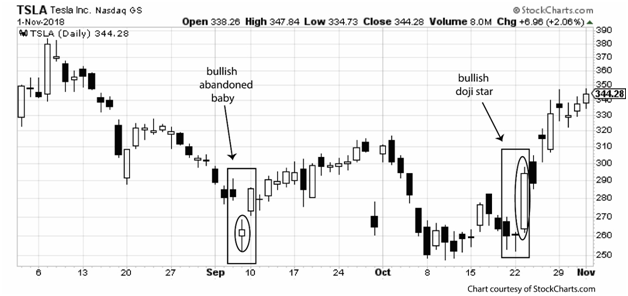
A characteristic of the true divergent bar reversal is that the day’s session open at a gap from the previous day, and then closes within the range of the previous real body (in the upper half for a bullish move, or in the lower half in a bullish divergence).
The divergent bar signal is exceptionally strong as a reversal, assuming it is also confirmed by other signals. For example, on the chart of Tesla (TSLA), two examples of divergent bars meet these three criteria: sessions move opposite the prevailing trend, they appear with gaps, and they are strongly confirmed. Perhaps most important, they lead to reversal as predicted.

In the first example, a downtrend was underway until early September and represented a 100-point decline from the high of $380 to $280 per share. The downward gap leading to the divergent bar was exceptionally large, especially compared to the typical price pattern preceding this action. The single-day islands was divergent and was the middle session of the bullish abandoned baby, confirming the divergence as a bullish reversal.
In the second example, a downtrend had been set from early October and a 70-point move by the third week of October was significant. After a brief retracement, price appeared to resume the downtrend until the long white candlestick reversed the trend. It also served as the third session in the bullish reversal, a bullish doji star. This was the beginning of an 80-point rally to the end of the chart.
The divergent bar has exceptional predictive strength, assuming independent confirmation is also present. It tends to create an immediate reversal rather than a deferred or delayed one. Some other signals, with less specific strength or proximity to resistance or support, may experience a delayed reaction or even turn out to be false signals. The divergent bar is worth searching for, given its stronger than average signaling strength.
Look for strong confirmation in the form of candlesticks. The examples in the above chart had two exceptional three-session reversals. There are many more than could appear. The key is to find reversal signals that contain gaps. This conforms well to the requirement for divergent bars; however, signals with gaps also tend to be stronger than average.
Other forms of reversal may include a volume spike; but the definition of a true spike should be kept in mind as well. A spike is a one- or two-day period with unusually high volume, and an immediate return to the more typical volume experienced previously.
Momentum provides another worthwhile form of confirmation, especially Relative Strength Index (RSI) that has moved below index 20 (bullish oversold) or above index 80 (bearish overbought). Moving averages also are worth tracking, especially using a 50-day and 200-day together. The reversal is based on crossover; however, moving averages are lagging signals, so use them with caution.
An exception to this is Bollinger Bands. Even though its moving average-based middle band is also lagging, the standard deviation of upper and lower bands can provide useful signals of coming retracement or reversal. When Bollinger Bands is combined with the t-line (8-day exponential moving average), the resulting channel is a powerful trend tracking signal.
Michael C. Thomsett is a widely published author with over 80 business and investing books, including the best-selling Getting Started in Options, coming out in its 10th edition later this year. He also wrote the recently released The Mathematics of Options. Thomsett is a frequent speaker at trade shows and blogs on his website at Thomsett Guide as well as on Seeking Alpha, LinkedIn, Twitter and Facebook.



There are no comments to display.
Join the conversation
You can post now and register later. If you have an account, sign in now to post with your account.
Note: Your post will require moderator approval before it will be visible.